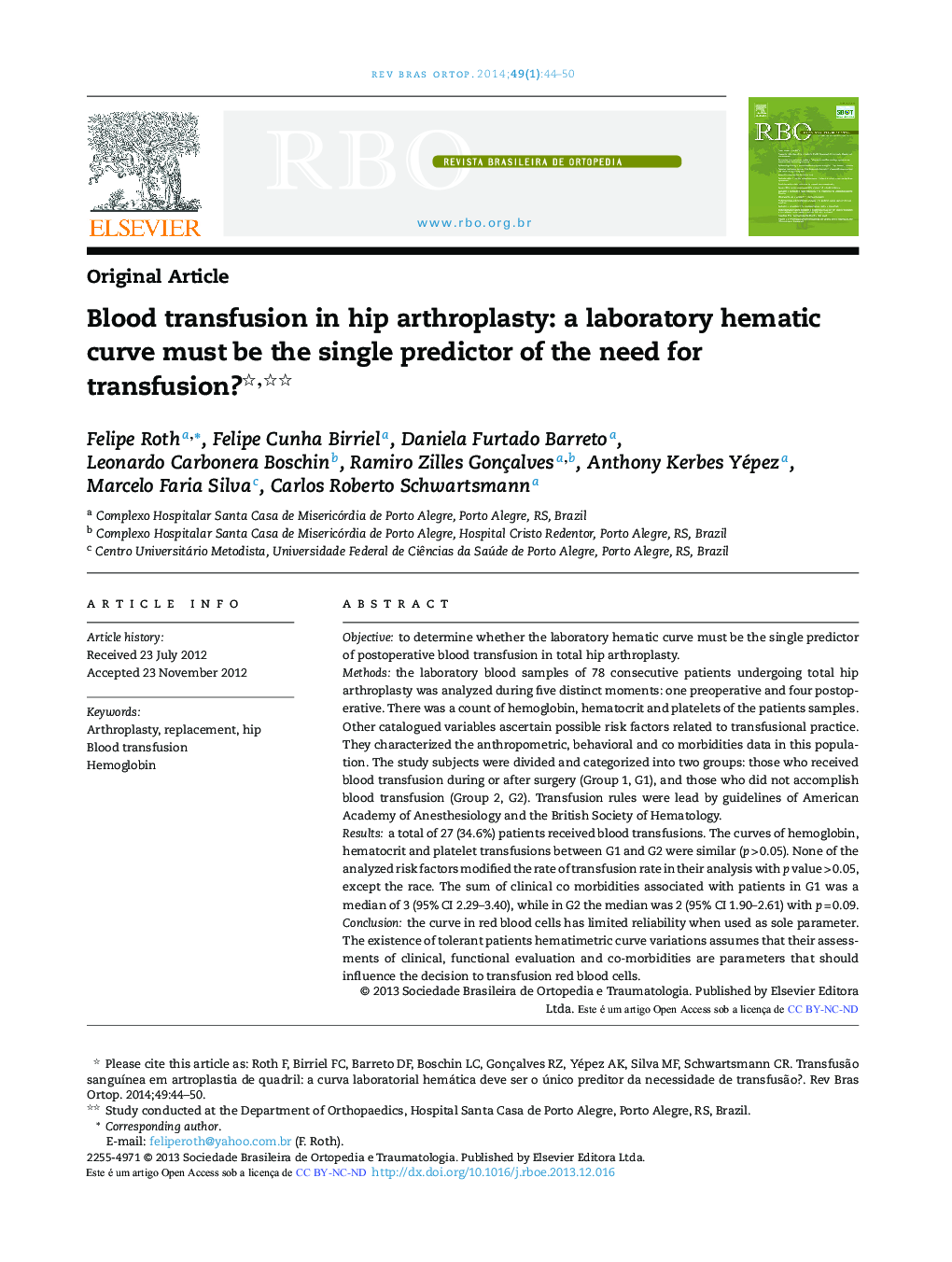| کد مقاله | کد نشریه | سال انتشار | مقاله انگلیسی | نسخه تمام متن |
|---|---|---|---|---|
| 2708561 | 1144907 | 2014 | 7 صفحه PDF | دانلود رایگان |
Objectiveto determine whether the laboratory hematic curve must be the single predictor of postoperative blood transfusion in total hip arthroplasty.Methodsthe laboratory blood samples of 78 consecutive patients undergoing total hip arthroplasty was analyzed during five distinct moments: one preoperative and four postoperative. There was a count of hemoglobin, hematocrit and platelets of the patients samples. Other catalogued variables ascertain possible risk factors related to transfusional practice. They characterized the anthropometric, behavioral and co morbidities data in this population. The study subjects were divided and categorized into two groups: those who received blood transfusion during or after surgery (Group 1, G1), and those who did not accomplish blood transfusion (Group 2, G2). Transfusion rules were lead by guidelines of American Academy of Anesthesiology and the British Society of Hematology.Resultsa total of 27 (34.6%) patients received blood transfusions. The curves of hemoglobin, hematocrit and platelet transfusions between G1 and G2 were similar (p > 0.05). None of the analyzed risk factors modified the rate of transfusion rate in their analysis with p value > 0.05, except the race. The sum of clinical co morbidities associated with patients in G1 was a median of 3 (95% CI 2.29–3.40), while in G2 the median was 2 (95% CI 1.90–2.61) with p = 0.09.Conclusionthe curve in red blood cells has limited reliability when used as sole parameter. The existence of tolerant patients hematimetric curve variations assumes that their assessments of clinical, functional evaluation and co-morbidities are parameters that should influence the decision to transfusion red blood cells.
ResumoObjetivoverificar se a curva laboratorial hemática deve ser o único preditor de transfusão sanguínea pós-operatória em artroplastia total de quadril (ATQ).Métodosamostras laboratoriais sanguíneas de 78 pacientes consecutivos submetidos à ATQ foram analisadas em cinco em períodos distintos (um pré-operatório e quatro pós-operatórios). Verificou-se a contagem de hemoglobina, hematócrito e plaquetas desses pacientes. Foram analisadas características antropométricas e comportamentais e comorbidades referentes à amostra, para verificação de fatores de risco associados à prática transfusional. Os indivíduos do estudo foram divididos em dois grupos: aqueles que receberam transfusão sanguínea foram alocados no Grupo 1 (G1) e os que não a receberam, no Grupo 2 (G2). As condutas transfusionais respaldaram-se dos critérios da Academia Americana de Anestesiologia e da Sociedade Britânica de Hematologia.Resultadosreceberam transfusão de hemoderivados 27 (34,6%) pacientes. As análises das curvas de hemoglobina, hematócrito e plaquetas entre o G1 e o G2 nas cinco visitas distintas foram similares (p > 0,05). Todos os fatores de risco analisados, com exceção da etnia, não apresentaram repercussões nos índice de transfusão em suas análises com valor p > 0,05. A soma das comorbidades clínicas associadas aos pacientes no G1 foi mediana de 3 (IC 95% 2,29–3,40), enquanto no G2 a mediana foi 2 (IC 95% 1,90–2,61) com valor p = 0,09.Conclusãoa curva hemática apresenta confiabilidade limitada quando usada como parâmetro exclusivo e absoluto. A existência de pacientes tolerantes às variações da curva hematimétrica pressupõe que as suas avaliações de caráter clínico, funcional e de comorbidades sejam parâmetros que devam influenciar na decisão do uso de hemoderivados.
Journal: Revista Brasileira de Ortopedia (English Edition) - Volume 49, Issue 1, January–February 2014, Pages 44–50
